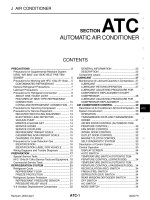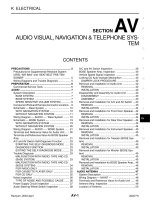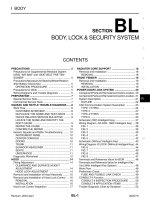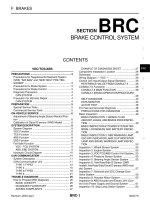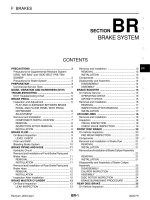EI nội THẤT, NGOẠI THẤT TRÊN XE INFINITI FX35, FX45 2003
Bạn đang xem bản rút gọn của tài liệu. Xem và tải ngay bản đầy đủ của tài liệu tại đây (1.86 MB, 46 trang )
EI-1
EXTERIOR & INTERIOR
I BODY
CONTENTS
C
D
E
F
G
H
J
K
L
M
SECTION EI
A
B
EI
Revision; 2004 April 2003 FX
EXTERIOR & INTERIOR
PRECAUTIONS 3
Precautions for Supplemental Restraint System
(SRS) “AIR BAG” and “SEAT BELT PRE-TEN-
SIONER” 3
Precautions for Work 3
PREPARATION 4
Special Service Tools 4
Commercial Service Tools 4
SQUEAK AND RATTLE TROUBLE DIAGNOSES 5
Work Flow 5
CUSTOMER INTERVIEW 5
DUPLICATE THE NOISE AND TEST DRIVE 6
CHECK RELATED SERVICE BULLETINS 6
LOCATE THE NOISE AND IDENTIFY THE
ROOT CAUSE 6
REPAIR THE CAUSE 6
CONFIRM THE REPAIR 7
Generic Squeak and Rattle Troubleshooting 7
INSTRUMENT PANEL 7
CENTER CONSOLE 7
DOORS 7
TRUNK 8
SUNROOF/HEADLINING 8
SEATS 8
UNDERHOOD 8
Diagnostic Worksheet 9
CLIP AND FASTENER 11
Clip and Fastener 11
FRONT BUMPER 14
Removal and Installation 14
REMOVAL 16
INSTALLATION 16
FRONT FILLET MOLDING ASSEMBLY 17
REAR BUMPER 18
Removal and Installation 18
REMOVAL 20
INSTALLATION 21
REAR BUMPER FASCIA 21
REAR BUMPER CLOSING 22
DRAFTER GUARD 22
REAR FILLET MOLDING ASSEMBLY 22
FRONT GRILLE 23
Removal and Installation 23
REMOVAL 23
INSTALLATION 23
COWL TOP 24
Removal and Installation 24
REMOVAL 24
INSTALLATION 24
FENDER PROTECTOR 25
Removal and Installation 25
REMOVAL 25
INSTALLATION 25
DOOR OUTSIDE MOLDING 26
Removal and Installation 26
FRONT DOOR OUTSIDE MOLDING 26
REAR DOOR OUTSIDE MOLDING 26
DOOR OUTSIDE LOWER MOLDING 27
Removal and Installation 27
FRONT AND REAR DOOR OUTSIDE LOWER
MOLDING 27
DOOR PARTING SEAL 28
Removal and Installation 28
REMOVAL 28
INSTALLATION 28
CENTER MUD GUARD 29
Removal and Installation 29
REMOVAL 29
INSTALLATION 29
WINDSHIELD MOLDING 30
Removal and Installation 30
REMOVAL 30
INSTALLATION 30
EI-2
Revision; 2004 April 2003 FX
BACK DOOR WINDOW MOLDING 31
Removal and Installation 31
REMOVAL 31
INSTALLATION 31
ROOF SIDE MOLDING 33
Removal and Installation 33
REMOVAL 33
INSTALLATION 33
ROOF RAIL 34
Removal and Installation 34
REMOVAL 34
INSTALLATION 34
ROOF RAIL BRACKET 34
DOOR FINISHER 35
Removal and Installation 35
DOOR FINISHER (FRONT AND REAR) 35
BODY SIDE TRIM 37
Removal and Installation 37
CENTER PILLAR LOWER GARNISH 37
CENTER PILLAR UPPER GARNISH 38
DASH SIDE FINISHER 38
FRONT PILLAR GARNISH 39
KICKING PLATE 39
CENTER MUDGUARD FINISHER (FRONT/
REAR) 39
FLOOR TRIM 40
Removal and Installation 40
REMOVAL 40
INSTALLATION 41
HEADLINING 42
Removal and Installation 42
REMOVAL 43
INSTALLATION 43
LUGGAGE FLOOR TRIM 44
Removal and Installation 44
REMOVAL 45
INSTALLATION 45
BACK DOOR TRIM 46
Removal and Installation 46
REMOVAL 46
INSTALLATION 46
BACK DOOR OUTSIDE FINISHER 46
PRECAUTIONS
EI-3
C
D
E
F
G
H
J
K
L
M
A
B
EI
Revision; 2004 April 2003 FX
PRECAUTIONS PFP:00001
Precautions for Supplemental Restraint System (SRS) “AIR BAG” and “SEAT
BELT PRE-TENSIONER”
AIS0057Y
The Supplemental Restraint System such as “AIR BAG” and “SEAT BELT PRE-TENSIONER”, used along
with a front seat belt, helps to reduce the risk or severity of injury to the driver and front passenger for certain
types of collision. This system includes seat belt switch inputs and dual stage front air bag modules. The SRS
system uses the seat belt switches to determine the front air bag deployment, and may only deploy one front
air bag, depending on the severity of a collision and whether the front occupants are belted or unbelted.
Information necessary to service the system safely is included in the SRS and SB section of this Service Man-
ual.
WARNING:
● To avoid rendering the SRS inoperative, which could increase the risk of personal injury or death
in the event of a collision which would result in air bag inflation, all maintenance must be per-
formed by an authorized NISSAN/INFINITI dealer.
● Improper maintenance, including incorrect removal and installation of the SRS, can lead to per-
sonal injury caused by unintentional activation of the system. For removal of Spiral Cable and Air
Bag Module, see the SRS section.
● Do not use electrical test equipment on any circuit related to the SRS unless instructed to in this
Service Manual. SRS wiring harnesses can be identified by yellow and/or orange harnesses or
harness connectors.
Precautions for Work AIS0057Z
● After removing and installing the opening/closing parts, be sure to carry out fitting adjustments to check
their operation.
● Check the lubrication level, damage, and wear of each part. If necessary, grease or replace it.
EI-4
PREPARATION
Revision; 2004 April 2003 FX
PREPARATION PFP:00002
Special Service Tools AIS00373
The actual shapes of Kent-Moore tools may differ from those of special service tools illustrated here.
Commercial Service Tools AIS00374
Tool number
(Kent-Moore No.)
Tool name
Description
(J-39570)
Chassis ear
Locating the noise
(J-43980)
NISSAN Squeak and Rattle
Kit
Repairing the cause of noise
SIIA0993E
SIIA0994E
Tool name Description
Engine ear Locating the noise
Power tool
SIIA0995E
PIIB1407E
SQUEAK AND RATTLE TROUBLE DIAGNOSES
EI-5
C
D
E
F
G
H
J
K
L
M
A
B
EI
Revision; 2004 April 2003 FX
SQUEAK AND RATTLE TROUBLE DIAGNOSES PFP:00000
Work Flow AIS00580
CUSTOMER INTERVIEW
Interview the customer if possible, to determine the conditions that exist when the noise occurs.Use the Diag-
nostic Worksheet during the interview to document the facts and conditions when the noise occurs and any
customer's comments; refer to EI-9, "
Diagnostic Worksheet" . This information is necessary to duplicate the
conditions that exist when the noise occurs.
● The customer may not be able to provide a detailed description or the location of the noise. Attempt to
obtain all the facts and conditions that exist when the noise occurs (or does not occur).
● If there is more than one noise in the vehicle, be sure to diagnose and repair the noise that the customer
is concerned about. This can be accomplished by test driving the vehicle with the customer.
● After identifying the type of noise, isolate the noise in terms of its characteristics.The noise characteristics
are provided so the customer, service adviser and technician are all speaking the same language when
defining the noise.
● Squeak —(Like tennis shoes on a clean floor)
Squeak characteristics include the light contact/fast movement/brought on by road conditions/hard sur-
faces=higher pitch noise/softer surfaces=lower pitch noises/edge to surface=chirping
● Creak—(Like walking on an old wooden floor)
Creak characteristics include firm contact/slow movement/twisting with a rotational movement/pitch
dependent on materials/often brought on by activity.
● Rattle—(Like shaking a baby rattle)
Rattle characteristics include the fast repeated contact/vibration or similar movement/loose parts/missing
clip or fastener/incorrect clearance.
● Knock —(Like a knock on a door)
Knock characteristics include hollow sounding/sometimes repeating/often brought on by driver action.
● Tick—(Like a clock second hand)
Tick characteristics include gentle contacting of light materials/loose components/can be caused by driver
action or road conditions.
● Thump—(Heavy, muffled knock noise)
Thump characteristics include softer knock/dead sound often brought on by activity.
● Buzz—(Like a bumble bee)
Buzz characteristics include high frequency rattle/firm contact.
● Often the degree of acceptable noise level will vary depending upon the person. A noise that you may
judge as acceptable may be very irritating to the customer.
● Weather conditions, especially humidity and temperature, may have a great effect on noise level.
SBT842
EI-6
SQUEAK AND RATTLE TROUBLE DIAGNOSES
Revision; 2004 April 2003 FX
DUPLICATE THE NOISE AND TEST DRIVE
If possible, drive the vehicle with the customer until the noise is duplicated. Note any additional information on
the Diagnostic Worksheet regarding the conditions or location of the noise. This information can be used to
duplicate the same conditions when you confirm the repair.
If the noise can be duplicated easily during the test drive, to help identify the source of the noise, try to dupli-
cate the noise with the vehicle stopped by doing one or all of the following:
1) Close a door.
2) Tap or push/pull around the area where the noise appears to be coming from.
3) Rev the engine.
4) Use a floor jack to recreate vehicle “twist”.
5) At idle, apply engine load (electrical load, half-clutch on M/T model, drive position on A/T model).
6) Raise the vehicle on a hoist and hit a tire with a rubber hammer.
● Drive the vehicle and attempt to duplicate the conditions the customer states exist when the noise occurs.
● If it is difficult to duplicate the noise, drive the vehicle slowly on an undulating or rough road to stress the
vehicle body.
CHECK RELATED SERVICE BULLETINS
After verifying the customer concern or symptom, check ASIST for Technical Service Bulletins (TSBs) related
to that concern or symptom.
If a TSB relates to the symptom, follow the procedure to repair the noise.
LOCATE THE NOISE AND IDENTIFY THE ROOT CAUSE
1. Narrow down the noise to a general area.To help pinpoint the source of the noise, use a listening tool
(Chassis Ear: J39570,Engine Ear and mechanics stethoscope).
2. Narrow down the noise to a more specific area and identify the cause of the noise by:
● removing the components in the area that you suspect the noise is coming from.
Do not use too much force when removing clips and fasteners, otherwise clips and fastener can be broken
or lost during the repair, resulting in the creation of new noise.
● tapping or pushing/pulling the component that you suspect is causing the noise.
Do not tap or push/pull the component with excessive force, otherwise the noise will be eliminated only
temporarily.
● feeling for a vibration with your hand by touching the component(s) that you suspect is (are) causing the
noise.
● placing a piece of paper between components that you suspect are causing the noise.
● looking for loose components and contact marks.
Refer to EI-7, "
Generic Squeak and Rattle Troubleshooting" .
REPAIR THE CAUSE
● If the cause is a loose component, tighten the component securely.
● If the cause is insufficient clearance between components:
– separate components by repositioning or loosening and retightening the component, if possible.
– insulate components with a suitable insulator such as urethane pads, foam blocks, felt cloth tape or ure-
thane tape. A Nissan Squeak and Rattle Kit (J-43980) is available through your authorized Nissan Parts
Department.
CAUTION:
Do not use excessive force as many components are constructed of plastic and may be damaged.
Always check with the Parts Department for the latest parts information.
The following materials are contained in the Nissan Squeak and Rattle Kit (J-43980). Each item can be
ordered separately as needed.
URETHANE PADS [1.5 mm (0.059 in) thick]
Insulates connectors, harness, etc.
76268-9E005: 100 × 135 mm (3.94 × 5.31 in)/76884-71L01: 60 × 85 mm (2.36 × 3.35 in)/76884-71L02:15
× 25 mm (0.59 × 0.98 in)
INSULATOR (Foam blocks)
Insulates components from contact. Can be used to fill space behind a panel.
73982-9E000: 45 mm (1.77 in) thick, 50 × 50 mm (1.97 × 1.97 in)/73982-50Y00: 10 mm (0.39 in) thick,
50 × 50 mm (1.97 × 1.97 in)
SQUEAK AND RATTLE TROUBLE DIAGNOSES
EI-7
C
D
E
F
G
H
J
K
L
M
A
B
EI
Revision; 2004 April 2003 FX
INSULATOR (Light foam block)
80845-71L00: 30 mm (1.18 in) thick, 30 × 50 mm (1.18 × 1.97 in)
FELT CLOTHTAPE
Used to insulate where movement does not occur. Ideal for instrument panel applications.
68370-4B000: 15 × 25 mm (0.59 × 0.98 in) pad/68239-13E00: 5 mm (0.20 in) wide tape roll The following
materials, not found in the kit, can also be used to repair squeaks and rattles.
UHMW(TEFLON) TAPE
Insulates where slight movement is present. Ideal for instrument panel applications.
SILICONE GREASE
Used in place of UHMW tape that will be visible or not fit.
Note: Will only last a few months.
SILICONE SPRAY
Use when grease cannot be applied.
DUCT TAPE
Use to eliminate movement.
CONFIRM THE REPAIR
Confirm that the cause of a noise is repaired by test driving the vehicle. Operate the vehicle under the same
conditions as when the noise originally occurred. Refer to the notes on the Diagnostic Worksheet.
Generic Squeak and Rattle Troubleshooting AIS00581
Refer to Table of Contents for specific component removal and installation information.
INSTRUMENT PANEL
Most incidents are caused by contact and movement between:
1. The cluster lid A and instrument panel
2. Acrylic lens and combination meter housing
3. Instrument panel to front pillar garnish
4. Instrument panel to windshield
5. Instrument panel mounting pins
6. Wiring harnesses behind the combination meter
7. A/C defroster duct and duct joint
These incidents can usually be located by tapping or moving the components to duplicate the noise or by
pressing on the components while driving to stop the noise. Most of these incidents can be repaired by apply-
ing felt cloth tape or silicon spray (in hard to reach areas). Urethane pads can be used to insulate wiring har-
ness.
CAUTION:
Do not use silicone spray to isolate a squeak or rattle. If you saturate the area with silicone, you will
not be able to recheck the repair.
CENTER CONSOLE
Components to pay attention to include:
1. Shifter assembly cover to finisher
2. A/C control unit and cluster lid C
3. Wiring harnesses behind audio and A/C control unit
The instrument panel repair and isolation procedures also apply to the center console.
DOORS
Pay attention to the:
1. Finisher and inner panel making a slapping noise
2. Inside handle escutcheon to door finisher
3. Wiring harnesses tapping
4. Door striker out of alignment causing a popping noise on starts and stops
Tapping or moving the components or pressing on them while driving to duplicate the conditions can isolate
many of these incidents. You can usually insulate the areas with felt cloth tape or insulator foam blocks from
the Nissan Squeak and Rattle Kit (J-43980) to repair the noise.
EI-8
SQUEAK AND RATTLE TROUBLE DIAGNOSES
Revision; 2004 April 2003 FX
TRUNK
Trunk noises are often caused by a loose jack or loose items put into the trunk by the owner.
In addition look for:
1. Trunk lid dumpers out of adjustment
2. Trunk lid striker out of adjustment
3. The trunk lid torsion bars knocking together
4. A loose license plate or bracket
Most of these incidents can be repaired by adjusting, securing or insulating the item(s) or component(s) caus-
ing the noise.
SUNROOF/HEADLINING
Noises in the sunroof/headlining area can often be traced to one of the following:
1. Sunroof lid, rail, linkage or seals making a rattle or light knocking noise
2. Sunvisor shaft shaking in the holder
3. Front or rear windshield touching headlining and squeaking
Again, pressing on the components to stop the noise while duplicating the conditions can isolate most of these
incidents. Repairs usually consist of insulating with felt cloth tape.
SEATS
When isolating seat noise it's important to note the position the seat is in and the load placed on the seat when
the noise is present. These conditions should be duplicated when verifying and isolating the cause of the
noise.
Cause of seat noise include:
1. Headrest rods and holder
2. A squeak between the seat pad cushion and frame
3. The rear seatback lock and bracket
These noises can be isolated by moving or pressing on the suspected components while duplicating the con-
ditions under which the noise occurs. Most of these incidents can be repaired by repositioning the component
or applying urethane tape to the contact area.
UNDERHOOD
Some interior noise may be caused by components under the hood or on the engine wall. The noise is then
transmitted into the passenger compartment.
Causes of transmitted underhood noise include:
1. Any component mounted to the engine wall
2. Components that pass through the engine wall
3. Engine wall mounts and connectors
4. Loose radiator mounting pins
5. Hood bumpers out of adjustment
6. Hood striker out of adjustment
These noises can be difficult to isolate since they cannot be reached from the interior of the vehicle. The best
method is to secure, move or insulate one component at a time and test drive the vehicle. Also, engine RPM
or load can be changed to isolate the noise. Repairs can usually be made by moving, adjusting, securing, or
insulating the component causing the noise.
SQUEAK AND RATTLE TROUBLE DIAGNOSES
EI-9
C
D
E
F
G
H
J
K
L
M
A
B
EI
Revision; 2004 April 2003 FX
Diagnostic Worksheet AIS00582
SBT860
EI-10
SQUEAK AND RATTLE TROUBLE DIAGNOSES
Revision; 2004 April 2003 FX
SBT844
CLIP AND FASTENER
EI-11
C
D
E
F
G
H
J
K
L
M
A
B
EI
Revision; 2004 April 2003 FX
CLIP AND FASTENER PFP:76906
Clip and Fastener AIS00378
SIIA0315E
EI-12
CLIP AND FASTENER
Revision; 2004 April 2003 FX
SIIA0316E
CLIP AND FASTENER
EI-13
C
D
E
F
G
H
J
K
L
M
A
B
EI
Revision; 2004 April 2003 FX
SIIA0317E
EI-14
FRONT BUMPER
Revision; 2004 April 2003 FX
FRONT BUMPER PFP:F2022
Removal and Installation AIS00379
CAUTION:
Bumper fascia is made of resin. Do not apply strong force to it, and be careful to prevent contact with
oil.
FRONT BUMPER
EI-15
C
D
E
F
G
H
J
K
L
M
A
B
EI
Revision; 2004 April 2003 FX
PIIA4330E
1. Bumper stay 2. Front bumper guard bar 3. Bumper reinforcement
4. Nut 5. Bolt 6. Energy absorber
EI-16
FRONT BUMPER
Revision; 2004 April 2003 FX
REMOVAL
1. Remove front grille. Refer to EI-23, "Removal and Installation" .
2. Remove bolts and clips connected fillet molding and front
bumper fascia.
3. Remove bolts and clips of front under cover.
4. Remove screws and clips of right/left fender protectors on front
side. Refer to EI-25, "
Removal and Installation" .
5. Remove bolts of right/left fender.
6. Insert driver rolled with cloth between bumper fascia and “S”
type clips, and remove bumper fascia.
7. Disconnect harness connector of fog lamps.
8. Remove bumper fascia assembly.
9. Remove bumper energy absorber.
10. Remove bolts and nuts of bumper reinforcement, and remove
bumper reinforcement. Remove bolts and nuts with power tool.
11. Remove ICC sensor with bracket. Refer to Refer to ACS-74,
"REMOVAL AND INSTALLATION" .
12. Remove nuts of bumper stay, and remove bumper stay. Remove
nuts with power tool.
13. Remove nuts of front bumper guard bar, and remove front
bumper guard bar. Remove nuts with power tool.
14. Remove fog lamps located in bumper fascia. Refer to LT-119,
"FRONT FOG LAMP" .
INSTALLATION
Install in the reverse order of removal.
7. Clip (C205) 8. Bumper fascia assembly 9. Number plate holder
10. Bolt 11. Bolt 12. Bolt
13. Nut 14. Bolt 15. Clip (“S” type)
16. Fillet molding 17. Bolt
PIIA4350E
PIIA4338E
PIIA4331E
PIIA4339E
FRONT BUMPER
EI-17
C
D
E
F
G
H
J
K
L
M
A
B
EI
Revision; 2004 April 2003 FX
FRONT FILLET MOLDING ASSEMBLY
Removal
1. Remove screws of fillet molding assembly.
2. Remove clips of fillet molding assembly.
3. Remove fillet molding assembly.
Installation
1. Clean adhesive portion of front fender with white gasolin.
2. Strip pattern from the new double-faced adhesive tape and paste on front fender.
3. Fillet molding assembly hold with front fender.
PIIA4350E
EI-18
REAR BUMPER
Revision; 2004 April 2003 FX
REAR BUMPER PFP:H5022
Removal and Installation AIS0037A
CAUTION:
Bumper fascia is made of resin. Do not apply strong force to it, and be careful to prevent contact with
oil.
REAR BUMPER
EI-19
C
D
E
F
G
H
J
K
L
M
A
B
EI
Revision; 2004 April 2003 FX
PIIA4333E
1. Bumper side cover A right 2. Bumper side cover A left 3. Special bolt
4. Clip (“S” type) 5. Bumper stay right 6. Bumper reinforcement
EI-20
REAR BUMPER
Revision; 2004 April 2003 FX
REMOVAL
1. Remove bumper side cover A right and left.
2. Remove screws and clips connected fillet molding and rear
bumper fascia.
3. Remove luggage side inspection cover.
4. Remove bumper fascia special bolts from right/left rear fender.
5. Remove bumper fascia bolts from right/left rear fender.
6. Remove lower portion of bumper fascia bolts.
7. Insert driver rolled with cloth between bumper fascia and “S”
type clips, and remove bumper fascia.
8. Remove bumper fascia assembly.
9. Remove bumper energy absorber.
10. Remove bumper reinforcement nuts and remove bumper rein-
force assembly. Remove nuts with power tool.
7. Nut 8. Bumper stay left 9. Nut
10. Energy absorber 11. Fillet molding left 12. Bumper closing left
13. Bolt 14. Bolt 15. Clip (C101)
16. Bolt 17. Clip (C205) 18. Bumper fascia assembly
19. Bumper closing right 20. Fillet molding right
PIIA4347E
PIIA4334E
PIIA4335E
PIIA4336E
REAR BUMPER
EI-21
C
D
E
F
G
H
J
K
L
M
A
B
EI
Revision; 2004 April 2003 FX
11. Remove bumper nuts and remove bumper stay. Remove nuts
with power tool.
INSTALLATION
Install in the reverse order of removal.
REAR BUMPER FASCIA
Removal
1. Remove rear fender cover bolt and remove rear fender.
2. Remove bracket clips and remove bracket.
3. Remove rear reflex reflector assembly screw and remove rear
reflex reflector assembly.
Installation
Install in the reverse order of removal.
PIIA4337E
PIIA4960E
PIIA6416E
PIIA6417E
EI-22
REAR BUMPER
Revision; 2004 April 2003 FX
REAR BUMPER CLOSING
Removal
Remove clips of bumper closing and remove rear bumper closing.
Installation
Install in the reverse order of removal.
DRAFTER GUARD
Removal
Remove clips and bolt of drafter guard and remove drafter guard.
Installation
Install in the reverse order of removal.
REAR FILLET MOLDING ASSEMBLY
Removal
1. Remove bolts of fillet molding assembly.
2. Remove clips of fillet molding assembly.
3. Remove fillet molding assembly.
Installation
1. Clean adhesive portion of rear fender with white gasoline.
2. Strip pattern from the new double adhesive tape and paste on rear fender.
3. Fillet molding assembly hold with rear fender.
PIIA4954E
PIIA4955E
PIIA4347E
FRONT GRILLE
EI-23
C
D
E
F
G
H
J
K
L
M
A
B
EI
Revision; 2004 April 2003 FX
FRONT GRILLE PFP:62310
Removal and Installation AIS0037B
REMOVAL
1. Remove turn fastener of grille.
2. Remove clips on upper side of grille.
3. Pull out grille pawls, and remove grille assembly.
INSTALLATION
Install in the reverse order of removal.
PIIA4349E
1. Front grille 2. Turn fastener (CG101) 3. Clip (C205)
4. Front bumper fascia
EI-24
COWL TOP
Revision; 2004 April 2003 FX
COWL TOP PFP:66100
Removal and Installation AIS0037C
REMOVAL
1. Remove clips of hood ledge cover and remove hood ledge cover.
2. Remove right/left wiper arms. Refer to WW-44, "
Removal and Installation of Front Wiper Arms, Adjust-
ment of Wiper Arms Stop Location" .
3. Remove cowl top seal rubber.
4. Remove clips of cowl top cover (right) and remove cowl top cover (right).
5. Remove clips, Cap and bolts and remove cowl top cover (left).
6. Remove washer hose from cowl top cover.
INSTALLATION
Install in the reverse order of removal.
PIIA4946E
1. Cowl top cover (right) 2. Clip (C205) 3. Hood ledge cover (right)
4. Cowl top seal rubber 5. Hood ledge cover (left) 6. Bolt
7. Cap 8. Cowl top cover (left)
FENDER PROTECTOR
EI-25
C
D
E
F
G
H
J
K
L
M
A
B
EI
Revision; 2004 April 2003 FX
FENDER PROTECTOR PFP:63840
Removal and Installation AIS0037D
REMOVAL
1. Remove bolts of fender protector front.
2. Remove clips of fender protector front.
3. Remove fender protector front.
4. Remove bolt of fender protector rear.
5. Remove clips of fender protector rear.
6. Remove fender protector rear.
INSTALLATION
Install in the reverse order of removal.
PIIA4326E
1. Fender protector front 2. Clip (C103) 3. Screw
4. Bolt 5. Fender protector rear 6. Clip

